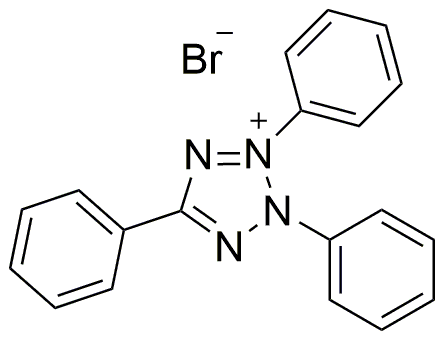2,3,5-Triphenyltetrazolium bromide is widely utilized in research focused on:
- Cell Viability Assays: This compound is commonly used in laboratories to assess cell viability and proliferation. It is reduced by living cells to form a colored formazan product, allowing researchers to quantify cell health and growth.
- Microbial Growth Studies: In microbiology, it serves as a vital indicator for assessing the metabolic activity of bacteria and fungi, helping researchers determine the effectiveness of antimicrobial agents.
- Pharmaceutical Development: The compound is instrumental in drug testing, where it helps evaluate the cytotoxic effects of new pharmaceuticals on various cell lines, ensuring safety and efficacy.
- Food Industry Applications: It is used to monitor the viability of foodborne pathogens, aiding in food safety assessments and ensuring that products meet health regulations.
- Environmental Monitoring: This chemical assists in evaluating the toxicity of pollutants in water and soil samples, providing crucial data for environmental protection efforts.
General Information
Properties
Safety and Regulations
Applications
2,3,5-Triphenyltetrazolium bromide is widely utilized in research focused on:
- Cell Viability Assays: This compound is commonly used in laboratories to assess cell viability and proliferation. It is reduced by living cells to form a colored formazan product, allowing researchers to quantify cell health and growth.
- Microbial Growth Studies: In microbiology, it serves as a vital indicator for assessing the metabolic activity of bacteria and fungi, helping researchers determine the effectiveness of antimicrobial agents.
- Pharmaceutical Development: The compound is instrumental in drug testing, where it helps evaluate the cytotoxic effects of new pharmaceuticals on various cell lines, ensuring safety and efficacy.
- Food Industry Applications: It is used to monitor the viability of foodborne pathogens, aiding in food safety assessments and ensuring that products meet health regulations.
- Environmental Monitoring: This chemical assists in evaluating the toxicity of pollutants in water and soil samples, providing crucial data for environmental protection efforts.
Documents
Safety Data Sheets (SDS)
The SDS provides comprehensive safety information on handling, storage, and disposal of the product.
Product Specification (PS)
The PS provides a comprehensive breakdown of the product’s properties, including chemical composition, physical state, purity, and storage requirements. It also details acceptable quality ranges and the product's intended applications.
Certificates of Analysis (COA)
Search for Certificates of Analysis (COA) by entering the products Lot Number. Lot and Batch Numbers can be found on a product’s label following the words ‘Lot’ or ‘Batch’.
Número de catálogo
Número de lote/lote
Certificates Of Origin (COO)
This COO confirms the country where the product was manufactured, and also details the materials and components used in it and whether it is derived from natural, synthetic, or other specific sources. This certificate may be required for customs, trade, and regulatory compliance.
Número de catálogo
Número de lote/lote
Safety Data Sheets (SDS)
The SDS provides comprehensive safety information on handling, storage, and disposal of the product.
DownloadProduct Specification (PS)
The PS provides a comprehensive breakdown of the product’s properties, including chemical composition, physical state, purity, and storage requirements. It also details acceptable quality ranges and the product's intended applications.
DownloadCertificates of Analysis (COA)
Search for Certificates of Analysis (COA) by entering the products Lot Number. Lot and Batch Numbers can be found on a product’s label following the words ‘Lot’ or ‘Batch’.
Número de catálogo
Número de lote/lote
Certificates Of Origin (COO)
This COO confirms the country where the product was manufactured, and also details the materials and components used in it and whether it is derived from natural, synthetic, or other specific sources. This certificate may be required for customs, trade, and regulatory compliance.


